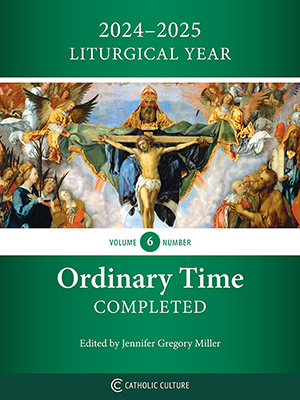Renewing Catholic education with Pope Leo XIV
By Dr. Jeff Mirus ( bio - articles - email ) | Oct 29, 2025
As you may have heard, Pope Leo issued an Apostolic Letter on October 27th, entitled Drawing New Maps of Hope, which we have added to our library. This new letter was written to commemorate the 60th anniversary of the Second Vatican Council’s Declaration on Christian Education (Gravissimum Educationis). As Pope Leo wrote in his Preamble:
[E]ducation is not an ancillary activity, but forms the very fabric of evangelization: it is the concrete way in which the Gospel becomes an educational gesture, a relationship, a culture…. Where educational communities allow themselves to be guided by the word of Christ, they do not retreat, but are revitalized…. They respond with creativity, opening up new possibilities for the transmission of knowledge and meaning…because the Gospel does not grow old but makes “all things new” (Rev 21:5). Each generation hears it as a regenerating novelty. Each generation is responsible for the Gospel and for discovering its seminal and multiplying power. [1.1]
The Pope goes on to note that we live in a complex, fragmented, digitized environment which requires that we renew Christian education so that it is capable of “interpreting the times, of preserving the unity between faith and reason, between thought and life, between knowledge and justice” (1.2). Yet now the need for an authentically Christian education is greater than ever, so “how can we not feel the urgency to renew our commitment?” Central to that renewal, regardless of particular styles of education, is to succeed in showing “a vision of man as the image of God, called to truth and goodness” (2.1).
Indeed, in section 3 of this document, the Pope insists that the foundation remains the same, that is, the person, capable of truth and relationship: “Therefore, the question of the relationship between faith and reason is not an optional chapter, or, as St. John Henry Newman put it, ‘Religious Truth is not only a portion, but a condition of general knowledge’” (3.1). Nor is this reliance on Newman accidental, for Pope Leo has declared Newman the co-patron of the Church’s educational mission along with St. Thomas Aquinas. Again remembering Newman, Leo writes:
We must also be careful not to fall into the trap of an enlightenment of a fides paired exclusively with ratio. We need to emerge from the shallows by recovering an empathic and open vision, and to understand better how humankind understands itself today in order to develop and deepen our teaching. This is why desire and the heart must not be separated from knowledge: it would mean splitting the person. Catholic universities and schools are places where questions are not silenced, and doubt is not banished, but accompanied. [3.1]
And Leo emphasizes that “Christian formation embraces the entire person: spiritual, intellectual, emotional, social, physical. It does not pit manual and theoretical skills, science and humanism, technology and conscience against each other”, and it opposes a “strictly mercantilist approach that often forces education today to be measured in terms of functionality and practical utility” (4.2).
The centrality of the person
In the fifth section of this brief letter, entitled “The centrality of the person”, the Pope reminds us that “Education is not only the transmission of content, but also the learning of virtues” (5.1). It requires a “path of common formation”, and demands not only that educators be open to new methodologies but open also to “spiritual and religious formation and sharing” (5.2). Leo also stresses that the “family remains the first place of education” and that Catholic schools collaborate with parents rather than substituting for them (5.3). The goal is always to form the whole person: “When it is true, faith is not an added ‘subject’, but a breath that oxygenates every other subject” (6.2).
In the seventh sub-section (“The contemplation of Creation”), the Pope incorporates a remarkable quotation from St. Bonaventure which is worth including here:
The entire world is a shadow, a pathway, an imprint. It is a book written from outside (Ez. 2:9), because in every creature there is a reflection of the divine model, but mixed with darkness. The world is, therefore, a path similar to opacity mixed with light; in this sense, it is a path. Just as you see how a ray of light entering through a window is colored according to the different colors of the different parts of the glass, the divine ray is reflected differently in each creature and takes on different properties.
For this reason, Pope Leo affirms, teaching will ideally have a certain plasticity, in that it must be tailored to different characters. He also affirms that an authentically Catholic education must continue to be open to “students and families who do not believe or who profess other faiths, but who desire a truly human education” (8.3). And in the next section he affirms that, especially in a world dominated by technology and digital “environments”, a “university and a Catholic school without vision risks soulless efficiency, the standardization of knowledge, which then becomes spiritual impoverishment” (9.1). He affirms that pastoral creativity is needed, warning that “no algorithm can substitute [for] what makes education human: poetry, irony, love, art, imagination, the joy of discovery and even learning from mistakes as an opportunity for growth” (9.2). And of course he warns against the use of an artificial intelligence that depersonalizes education and formation (9.3).
Adding to the Compact on Education
In section 10, Leo refers to the Global Compact on Education which was developed in collaboration with Pope Francis, citing its seven “pathways”—but he wishes to supplement these by adding three priorities. “The first,” he insists, “regards the inner life. Young people ask for depth; they need spaces for silence, discernment, and dialogue with their conscience and with God.” To this he adds, in the face of technology and artificial intelligence, the need to put “the person before the algorithm” such that the technical, emotional, social, spiritual and ecological can be formative of a genuine intelligence. Finally, he wishes to emphasize “non-violent language, reconciliation, bridges and not walls”, for “Blessed are the peacemakers” (Mt 5:9) should in a sense become “the method and content of learning” (10.3).
In the same section he stresses the need to secure Catholic educational access to those who cannot normally afford it: “Evangelical gratuitousness is not rhetoric: it is a style of relationship, a method and an objective” (10.4). (In case the point of this remark is missed, I would like to highlight its wisdom: The more we can free people from the tyranny of public schools and universities so that they can be given an authentically Catholic education, the better will be both the education and those who receive it.)
In the final section, “11. New maps of hope”, Pope Leo emphasizes the need to continue and enhance “a living tradition that extends towards new forms of presence and service”, but also a “courageous revision, without losing fidelity to the Gospel”. He wants Catholic education to be a “a beacon: not a nostalgic refuge, but a laboratory of discernment, pedagogical innovation and prophetic witness” (11.1). Finally, he exhorts all involved in education and formation to be true servants of education, “choreographers of hope, tireless seekers of wisdom, credible creators of expressions of beauty”, moving always “towards the truth that sets us free (cf. Jn 8:32), towards the fraternity that consolidates justice (cf. Mt 23:8), towards the hope that does not disappoint (cf. Rom 5.5)”.
All comments are moderated. To lighten our editing burden, only current donors are allowed to Sound Off. If you are a current donor, log in to see the comment form; otherwise please support our work, and Sound Off!
-
Posted by: Jeff Mirus -
Oct. 31, 2025 2:08 PM ET USA
dsharples13215: What you say is true. But we should not forget that two other things are also true: First, that most Catholic schools can provide some forms of financial assistance; second, that huge numbers of Catholic parents remain uncommitted to finding alternatives to the public school system, even alternatives as inexpensive (albeit demanding) as home schooling. This is only sometimes a problem that can be blamed entirely on lack of resources. There is a very widespread lack of commitment among too many Catholic parents, who have not yet awakened to their obligation to prioritize the salvation of their children. Moreover, for the vast majority of students, it is not a workable plan to put them in (authentically) Catholic elementary schools but not high schools, or in Catholic high schools but not colleges. Moreover, as I have written elsewhere, grandparents and close relatives who have few or no children should be helping larger Catholic families with tuition.
-
Posted by: dsharples13215 -
Oct. 30, 2025 11:21 PM ET USA
“ The other, of course, is that more Catholic parents need to realize they have a serious moral and spiritual obligation to avoid the public schools, even at great cost to their budgets..” Let’s look a the math here, before college: (8K * 8years + 16K * 4years) * 3children = 256K Yearly average that’s 256K / 12years =21.333 K/year It seems this is a surprise to you, but most middle-class families simply can’t afford that, no matter how they look into their budgets.
-
Posted by: Jeff Mirus -
Oct. 30, 2025 5:19 PM ET USA
dsharples13215: This is an extremely important point, though there are two issues here. One is that Catholics need to be generous about providing schooling for those who genuinely cannot afford private schooling even if they seriously wish to avoid public schools. The other, of course, is that more Catholic parents need to realize they have a serious moral and spiritual obligation to avoid the public schools, even at great cost to their budgets.
-
Posted by: dsharples13215 -
Oct. 30, 2025 7:40 AM ET USA
Brick and mortar Catholic Schools in my area are $8K per student for grade school and $16K per student for high school. There is assistance available but... that assistance goes to a very few (in comparison to the population) and very lucky poorer children. Middle class who are neither eligible for assistance, nor can afford the schools if they have more than 1 or 2 children are excluded. If this doesn't change, either by promoting home schooling or affordable schools for all... nothing will-








